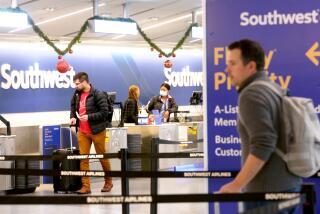COLUMN ONE : Thousands Miss Their Flights : Small cities are losing airline service as government subsidies end. Many feel like remote islands where ships no longer come to call.
- Share via
BLYTHE, Calif. — Once a month, Robert D. Briggs, warden of the Chuckawalla Valley State Prison, has to travel to Sacramento for a meeting of all of California’s prison wardens. Until recently, he flew out of this sleepy desert farming community, made a connection in Los Angeles and completed the round trip in one day.
But those days are gone--apparently forever--and Briggs has a much longer and more difficult trek. Now, to get to the state capital, he must drive four hours to Ontario to catch a flight. (He could also drive to Phoenix or Las Vegas to catch a plane, but those flights are longer and more expensive.) And the trip now involves a night away from home.
The reason for Briggs’ predicament is that Blythe--in southeastern California near the Arizona border--is one of a number of small communities that have recently lost scheduled commercial air service because government subsidies have been ended. Since the beginning of the year, it has been impossible to fly to or from Blythe, a city in the center of a region where about 17,000 people live.
Residents of communities like Blythe now must depend on their own cars or on bus or rail service, which have also been greatly reduced in recent years. And when a nationwide strike of Greyhound bus drivers began recently, the vulnerability and isolation of people who have no regularly scheduled air service became more evident and more serious.
In some cities the cutbacks can have severe economic consequences, affecting big corporations and little businesses alike. Community leaders fear that elimination of flight service will stymie economic development and hurt civic pride. The effects of the loss of commercial aviation have been felt from Blythe to Elkhart, Ind.; Sidney, Neb.; Mansfield, Ohio, and New Bedford, Mass.
Besides the inconvenience the cutbacks have caused for people who fly on business, they have also seriously affected private travel. For example, people here are unable to move quickly when family emergencies arise, and vacations are sometimes more awkward, with arrangements having to be made to leave cars parked at distant airports for weeks.
“Blythe is like an island not being served by any ships,” complained Floie Barrows, president of the Blythe Chamber of Commerce. “For the first time in several decades this area has been growing. My main concern is that new employers looking to locate here will hesitate to do so because you can’t get people in and out of this valley by air.”
The loss of air service can be costly in other ways, too. The State of California must pay more than $4,000 a month in additional mileage and per diem costs incurred by the 6 to 10 prison officials who travel out of Blythe every month and for the like number who come here to visit the facility, Warden Briggs calculated. That’s not counting the work-days lost as a result of the extra traveling.
Blythe’s twice-a-day flights were operated by a small, Los Angeles-based carrier named Air LA.
But then Congress swung the budget ax, slashing funds that had subsidized airlines that were losing money in some cities they served. With the disappearance of the government handouts, the airlines stopped flying to many of those communities, including Blythe.
Twenty airports serving 25 communities were affected by this first round of cuts, which totaled $6.6 million, from what is known as the Essential Air Service program. Some have already lost their service but city leaders in some of the communities are fighting to save it--trying to persuade the airlines to continue the service even though the subsidies have ended.
The subsidies have been controversial, with opponents maintaining that in the years since deregulation communities should have patronized their airlines enough to put them on a solid financial footing. They add that the airline subsidies have been much too high, compared to the $25 a passenger that the Amtrak railroad service receives.
Perhaps most tellingly, they ask whether all Americans should be taxed to support airline service to small towns.
Supporters argue that the communities helped by the subsidies have needed them to survive and grow. Providing such funds, they say, is “a normal function of government.”
“What we are trying to say is that for some of these small rural communities this is the only means of public transportation,” said Linda Daschle, vice president for federal affairs of the American Assn. of Airport Executives. “When Congress passed the deregulation act, no one said that we were going to totally eliminate air service to parts of our country.
“While it is true that the per-passenger subsidy for Amtrak passengers is much less than those for EAS, you cannot compare the two. Amtrak serves large metropolitan areas where there is also a lot of competition from the large commercial airlines, and people have a choice of how they want to travel.”
In a few of the affected communities, residents don’t care much whether their local airports are served by commercial airliners. An hour’s drive to a large airport with many available flights is sometimes seen as beating the high fares and poor service they had been subjected to by the small and financially shaky airlines that were providing the subsidized service.
The cuts that took place Jan. 1 are probably only the beginning. The U.S. Department of Transportation, which administers the Essential Air Service funds, has said that in the next fiscal year subsidies affecting air service to other localities will be whittled. The 1991 EAS funding of $24 million represents another $6 million reduction from the 1990 level.
When airline deregulation went into effect in 1978, there were 350 communities getting subsidized airline service, with about half of them in Alaska. Since then, many communities have generated enough traffic so that the airlines serving them no longer require such financial assistance.
Since the Jan. 1 cuts, 130 communities are still being subsidized--90 in the 48 lower states and 40 in Alaska.
Many of the Alaskan subsidies will continue because air service is the only practical means of transportation in some areas. But most of the 90 communities in the lower 48 are trying hard to fend off the threat to their airline service.
Congress is “slicing us as if we are salami,” said Raymond J. Rasenberger, a Washington, D.C., lawyer who represents a group of about 50 of the cities. “They are going to continue this approach until there is nothing left.”
John V. Coleman, director of the Transportation Department’s Office of Aviation Analysis, hints that the end of the program is in sight, with the exception of the Alaskan subsidies. “It could become worse in the future. In this fiscal year and for subsequent years (we will) pare back,” he said.
“It would be too traumatic to discontinue the program in its entirety right now,” he added. “But we have an obligation to do an evaluation and to make some cuts. The cost of continuing to subsidize air service . . . exceeds the benefit. . . . There is a strong case for weeding down.”
But the trend has been strongly criticized within the airline industry.
“As 1990 dawns, 20 more small towns are cut to meet even more tight-fisted standards,” said a newsletter published by Avmark, an aviation marketing and management service in Arlington, Va. “Billions are spent to subsidize so-called mass transit in big cities, a half billion for Amtrak, and almost three-quarters of a billion for America’s moribund merchant marine. How about a program to restore decent air service to America’s heartland?”
The loss of air service has had drastic consequences in some communities.
Local businessmen who depend on tourists and other visitors feel the pinch within days after the flights end. Small establishments--from gas stations and cab drivers to restaurants and motels--suffer most.
Loss of its air service hit Elkhart, Ind., particularly hard.
The city, the nation’s recreational vehicle manufacturing capital, was served until January by Iowa Airlines, a small commuter carrier. But when its subsidies for Elkhart were eliminated, the carrier discontinued the flights, saying that not enough passengers took the only route available: from Elkhart to Chicago’s Midway Airport.
According to Robert L. Kelso, president of the city’s chamber of commerce, individuals flew here to buy vehicles and professional drivers came to pick them up for sale by distributors elsewhere. Once able to fly to Elkhart, they now must fly to South Bend, 22 miles away, and drive to Elkhart.
As a result, Kelso said, they don’t buy fuel in Elkhart anymore, and they don’t spend much there on lodging or meals. If they stay overnight, it’s in South Bend hotels. Already, one motel has filed for bankruptcy, according to James G. Cobb, manager of Elkhart’s airport, and other businesses are in danger of collapse.
New Bedford and Fall River, two Massachusetts cities only a few miles apart, are also victims of the cutbacks. Fall River hasn’t had air service for some years, but New Bedford’s airport served both communities until the subsidy was ended in January.
A great deal of New York City’s garment industry’s goods are made in the New Bedford-Fall River area. “The high-fashion designers come up here from New York,” said Mark Montigny, president of the Fall River Chamber of Commerce and Industry. “So do buyers and sellers of firms and their corporate executives. Just as many (local people) go down to New York.
“We’re close enough to Boston and Providence that they can drive here from there, so we are not dying from it. But we cannot say anymore that we’re 10 minutes from the nearest air service.”
Montigny said the lack of air service has also badly hurt the more than 200 apparel factory outlets in the Fall River-New Bedford area.
People used to fly to New Bedford for shopping sprees, he said, at the beginning of their vacations. “Tens of millions of dollars were spent between Fall River and New Bedford. Now, with the loss of airline service, we have lost one big market we used to exploit.”
The Essential Air Service program was created as part of the legislation that deregulated the airlines. Deregulation allowed airlines to fly wherever money could be made. Carriers dropped unprofitable routes and moved their planes to more lucrative markets.
The EAS was designed to ensure that smaller communities would continue to get at least minimal air service, even though without the subsidies it would be a money-loser for the airlines.
When the recent spending reductions were imposed by Congress, the Department of Transportation came up with criteria for loss of subsidies in the first round of cuts. One was the degree of isolation that would be caused to a community by loss of air service, with communities near other airports the first to be affected.
The size of the subsidy was also considered, for the airlines had been subsidized for the losses they incurred on a route on a per-passenger basis. The difference between expenses and revenues on a route equaled the amount of the subsidy.
If the subsidy was more than $200 a passenger, the route was considered to have too few passengers to make it worth flying. So if an airline was losing so much that it required a subsidy that big, the payments were eliminated.
Some communities lost their service because almost no one used it. The Transportation Department reasoned that they thus would not suffer undue hardship. Columbus, Neb., for example, had an average of only 1.4 passenger boardings daily. In Winslow, Ariz., the number was 1.8 and in McAlester, Okla., it was 1.6.
Leaders of such communities, however, say that the reason there was such scant use of the subsidized flights was that the fares were high and the service bad.
For some communities, the lack of air service threatens efforts to attract new industry, officials say.
The subsidy to serve Huron, S.D., is being continued only on a month-to-month basis while the community tries to find a new airline to take over the service from Masaba Airlines, which is losing money and plans to get out.
Hal Bisch, president of the Greater Huron Development Corp., said the community recently lured a new industry from St. Paul, Minn.--the Trussbilt Co., a division of Lanier Industries. “The move was dependent on a number of things,” Bisch maintained. “Without air transportation, this community would not have been in contention.
“We’re going to have to work with the federal government,” he said. “Otherwise these (small) communities are going to dry up, and the big cities are going to get bigger, and the cost of operations for everything is going to be higher than it is out here.”
And there are other communities that lost their subsidies where service continues temporarily at least.
Salem, Ore., for example, is served by Horizon Airlines, which until Jan. 1 received a subsidy of $37 a passenger to break even. In hopes of becoming self-sufficient, the airline will continue service a little longer.
When you want to lure big firms to your community, “one of the questions they ask is: ‘Can you fly there?’ ” said John Elegant, superintendent of the Salem Municipal Airport. “They want to fly to San Francisco and change planes to Salem. If the only way to get here is by chartering a plane, people don’t consider that air service.”
But community pride often enters the picture.
Battle Creek, Mich., was one of the cities that formally lost its air service subsidies Jan. 1. But it had not held the carrier that served it, Air Wisconsin, to its required two trips a day for some time before that.
“There was no incentive for anyone in our community to use it,” said Lugene Demarest, manager of the Battle Creek airport, which still serves general aviation. “They did not give us good service and good fares. . . . We had to have something usable, or what was the use of keeping it?”
Demarest conceded that having no air service “hurts community pride.” She says this is especially so because Kalamazoo, Mich. is only 22 miles away and Battle Creek residents now have to use that airport. “Any time you have two cities so close together, there is a good deal of rivalry.”
But through the generosity of its neighbor, Battle Creek can continue to hold its head high. The Kalamazoo Airport has been renamed the Kalamazoo-Battle Creek International Airport.
TICKET PRICES--A study finds plane fares are higher than they would have been without deregulation. D1
DECLINING AIR SERVICE
Map shows small communities across the country that were affected by the Jan. 1 loss of federal subsidies for commercial air service. Some of the towns have lost service altogether; others are battling to keep it going. Arizona: 1 Winslow California: 2 Blythe Indiana: 3 Elkhart Iowa: 4 Clinton Massachusetts: 5 New Bedford 6 Fall River Michigan: 7 Benton Harbor 8 St. Joseph 9 Jackson 10 Battle Creek Nebraska: 11 Sidney North Carolina: 12 Rocky Mount 13 Wilson 14 Winston-Salem Ohio: 15 Mansfield Oklahoma: 16 McAlester Oregon: 17 Salem Tennessee: 18 Clarksville Kentucky: 19 Ft. Campbell 20 Hopkinsville Texas: 21 Brownsville 22 Temple Vermont: 23 Montpelier 24 Barre Wisconsin: 25 Manitowoc Source: Department of Transportation
More to Read
Sign up for The Wild
We’ll help you find the best places to hike, bike and run, as well as the perfect silent spots for meditation and yoga.
You may occasionally receive promotional content from the Los Angeles Times.






